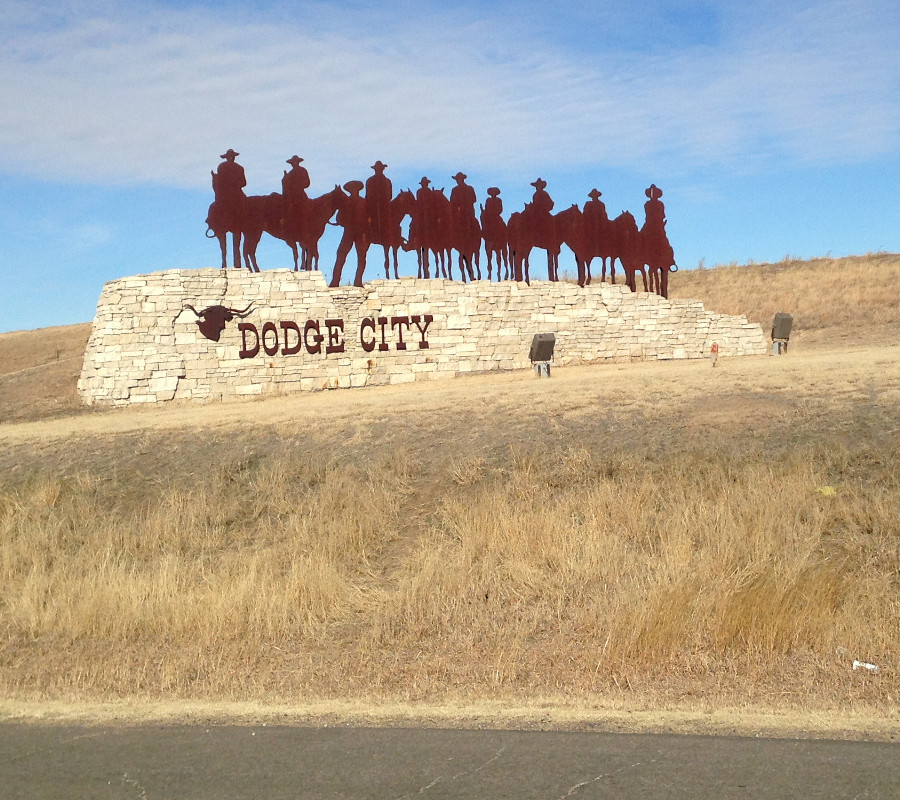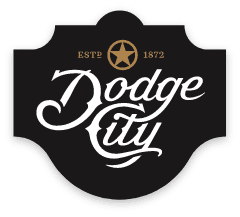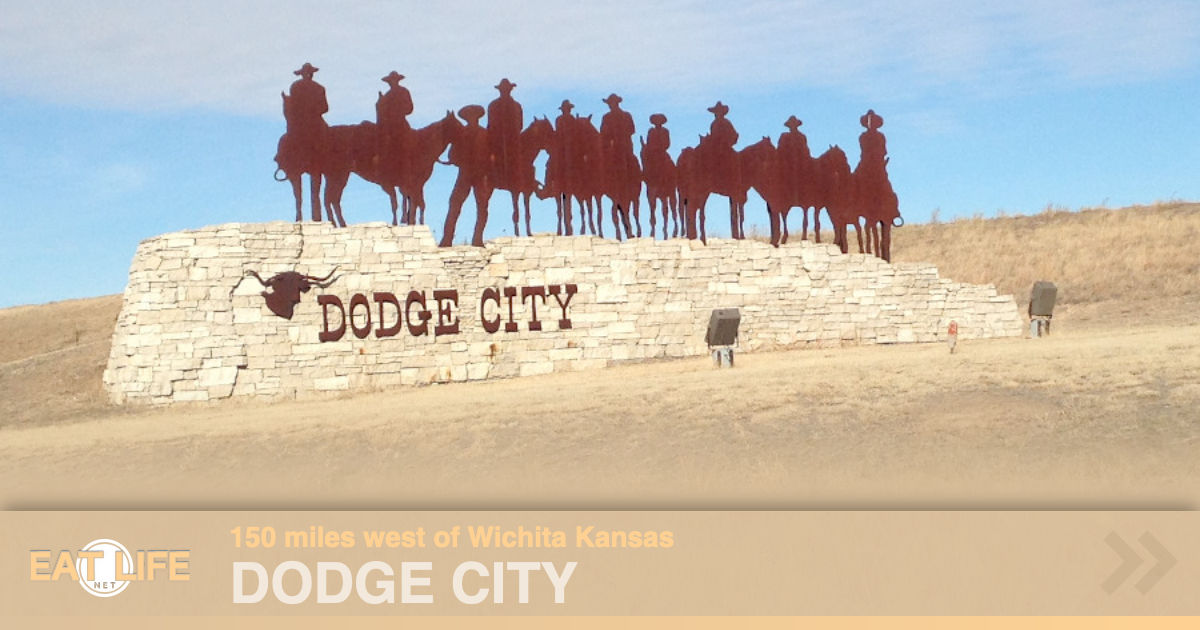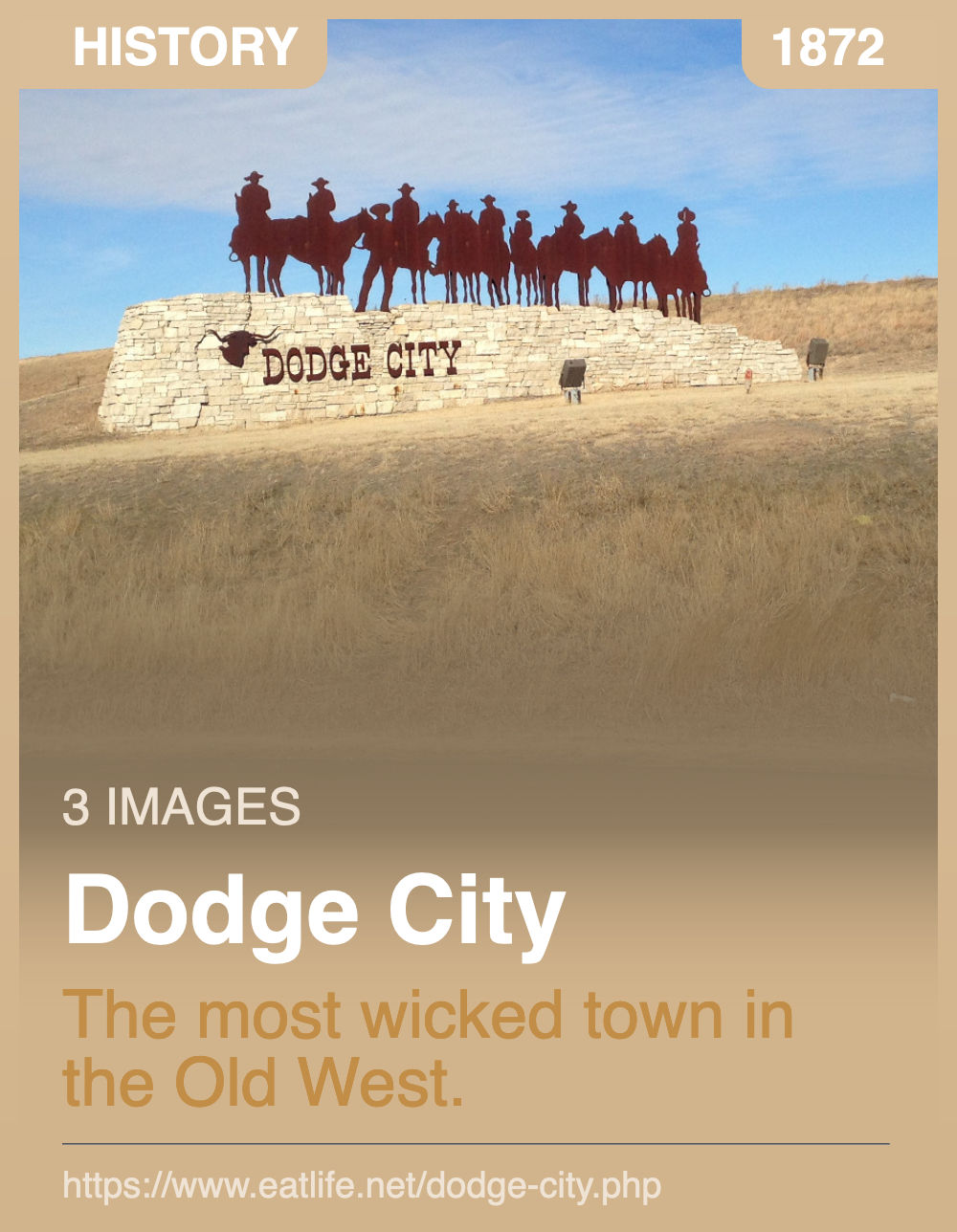Once called home by such notables as Wyatt Earp, Doc Holliday, Big Nose Kate, and Clay Allison, this old town had a reputation for being the most wicked town in the Old West.
In 1865, Fort Dodge was established near the present site of Dodge City. The fort was named after General Grenville Dodge. During these rough times, the pioneers were often attacked by marauding Indians. The Fort offered protection to the wagon trains from the Indians, provided mail service, and served as a supply base for troops engaged in the Indian Wars to the south.
The long Santa Fe Trail between Franklin, Missouri, and Santa Fe, New Mexico, saw thousands of wagons pass as they traveled the Mountain Branch west of Dodge City along the north bank of the Arkansas River into Colorado.A shorter but more dangerous route to Santa Fe was the Cimarron Cutoff, which crossed the river near Dodge City, heading southwest to the Cimarron River. This trail was much more dangerous due to the vast spaces of waterless sand hills and increased risk of Indian attacks.
In spite of all the hazards, this route was preferred by many traders and travelers because there were no mountains to be crossed and the distance to Santa Fe was somewhat shorter than the Mountain Route.
In 1871, a rancher by the name of Henry L. Sitler constructed a three-room sod house five miles west of Fort Dodge. At the foot of a hill along the Santa Fe Trail, Sitler's home became a frequent stopping place for buffalo hunters and traders. Of the Santa Fe Trail and its many wagon trains, Sitler would later say, "If you stood on the hill above Dodge City, there was traffic as far as you could see, 24-hours a day, seven days a week on the Santa Fe Trail."
Soon, another man by the name of George M. Hoover would join Sitler, building Dodge City's first business, a saloon built of sod and boards.
On August 15, 1872, a group of businessmen from Forts Dodge, Riley, and Leavenworth, Kansas, organized the Dodge City Town Company and began the planning and development of the townsite. At first, the settlement was named Buffalo City until they learned there was already a town by that name, so it was changed to Dodge City after the fort.
In September 1872, the Atchison, Topeka & Santa Fe Railroad arrived in Dodge City, which would initiate tremendous growth for many years. Adjacent to the railroad tracks, hastily built frame buildings and tents sprang up, housing two grocery and general merchandise stores, a dance hall, a restaurant, a barbershop, and a blacksmith shop.
One of the directors of the Town Company, a man by the name of Robert M. Wright, would say of this time:"Hardly had the railroad reached there, long before a depot could be built..., business began; and such a business! Dozens of cars a day were loaded with hides and meat, and dozens of carloads of grain, flour, and provisions arrived each day. The streets of Dodge were lined with wagons, bringing in hides and meat and getting supplies from early morning to late at night... I have been to several mining camps where rich strikes had been made, but I never saw any town to equal Dodge."
There was initially no law enforcement in the burgeoning settlement, and Dodge City quickly acquired its infamous stamp of lawlessness and gunslinging.
As many buffalo hunters, railroad workers, drifters, and soldiers streamed into the town after long excursions on the prairie, they quickly found the saloons, and the inevitable fights ensued.
With the gunfighters dying with their boots on, Dodge City developed the Boot Hill Cemetery, which was used until 1878.
Buffalo Capital of the West:
Dodge City became the buffalo capital of the west, and buffalo hides towered along Front Street awaiting shipment.
Filthy buffalo hunters and traders filled the town's establishment, and the term "stinker" was coined.
That's until General William Sherman, Army Commander-in-Chief, ordered the slaughter of buffalo in order to drive the Indians onto reservations, then the prairie was littered with decaying carcasses.
Though Sherman's tactic of killing the buffalo was effective in winning the Indian Wars, it placed hundreds of buffalo hunters out of business.
Most buffalo were gone by 1876, but over 1 1/2 million hides had been shipped from Dodge City on the railroad.
During hard times, farmers gathered the buffalo bones for years and sold them for six to eight dollars a ton. The bones were used in the manufacture of china and fertilizer.
Longhorn Cattle:
Though the buffalo no longer offered a revenue source for the townspeople, the cattle drives replaced the buffalo hunters.
By the spring of 1876, the cattle trade had shifted west from Ellsworth and Wichita, Kansas, to Dodge City.
As the Longhorn cattle from Texas were driven up the Chisholm Trail's western branch to the railroad at Dodge City, the settlement was alive again.
During the next 10 years, over 5 million head were driven on the trail into Dodge City.
Wyatt Earp:
But the cowboys brought even more lawlessness to Dodge City, and soon the mayor contacted Wyatt Earp, who was working as a Wichita lawman. Pleading for Earp's help, he offered Wyatt the Chief Deputy Marshal position with an unheard-of salary of $250 per month.
When Wyatt arrived, Dodge City's population was 1,200, and 19 businesses were licensed to sell liquor.
Soon, four assistant deputies were hired — Bat Masterson, Wyatt's old buffalo hunting friend; Charlie Basset; Bill Tilghman; and Neal Brown.
Peace Commission:
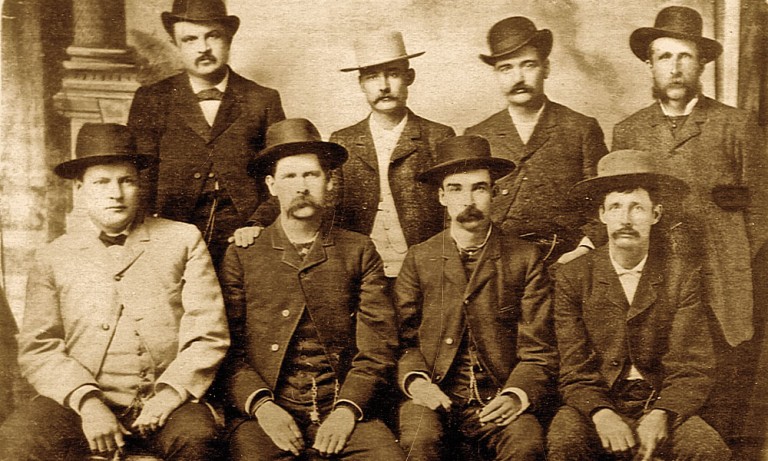
Dodge City Peace Commission
June 10, 1883:
From left to right:
Standing: William H. Harris, Luke Short, Bat Masterson, William F. Petillon
Seated: Charlie Bassett, Wyatt Earp, Michael Francis "Frank" McLean, Cornelius "Neil" Brown
IMAGE:[]
[https://en.wikipedia.org/wiki/Dodge_City,_Kansas]
Intending to restore order, one of the first things the new lawmen did was to initiate a "Deadline" north of the railroad yards on Front Street to keep the commercial part of the city quiet. On the north side, the city passed an ordinance that guns could not be worn or carried. On the south side of the "deadline," those who supported the lawlessness continued to operate as usual, with a host of saloons, brothels, and frequent gunfights.
The expression "Red Light District" was coined in Dodge City when the train masters took their red caboose lanterns with them when they visited the town's brothels.
The gun-toting rule was in effect around the clock, and anyone wearing a gun was immediately jailed. Soon, Dodge City's jail was filled.
Doc Holiday was a Dentist:
In 1878, Doc Holliday arrived in Dodge City with Big Nose Kate Elder, posing as his wife.
Settling in room 24 of the Dodge House, Doc mostly drank and gambled, but occasionally, he provided professional services to the townspeople.
Shortly after his arrival, an ad appeared in the Dodge City Times, pronouncing: "J.H. Holliday, Dentist, very respectfully offers his professional services to the citizens of Dodge City and surrounding country during the summer."
Gambling ranged from a game of five-cent "Chuck-aluck" to thousand dollar poker pots.
Tombstone:
In September 1879, Virgil Earp sent word to Wyatt of the boom in Tombstone, and Wyatt headed West with Doc Holliday following shortly thereafter.
By January 1880, Bat Masterson also left Dodge City for the West.
In 1880:
The Santa Fe Railroad reached Santa Fe, marking the Santa Fe Trail's death and the many travelers passing through Dodge City.
With the Indians effectively "lodged" on reservations, there was no longer a need for a military presence, and Fort Dodge was closed in 1882.
By 1886, the cattle drives had stopped.
Today, Dodge City is home to about 30,000 people. 100,000 tourists visit each year.
[
 ]
][https://www.legendsofamerica.com/ks-dodgecity/]
[
 ]
][http://www.kansashistory.us/fordco/dodgecity.html]
[
 ]
][https://en.wikipedia.org/wiki/Dodge_City,_Kansas]
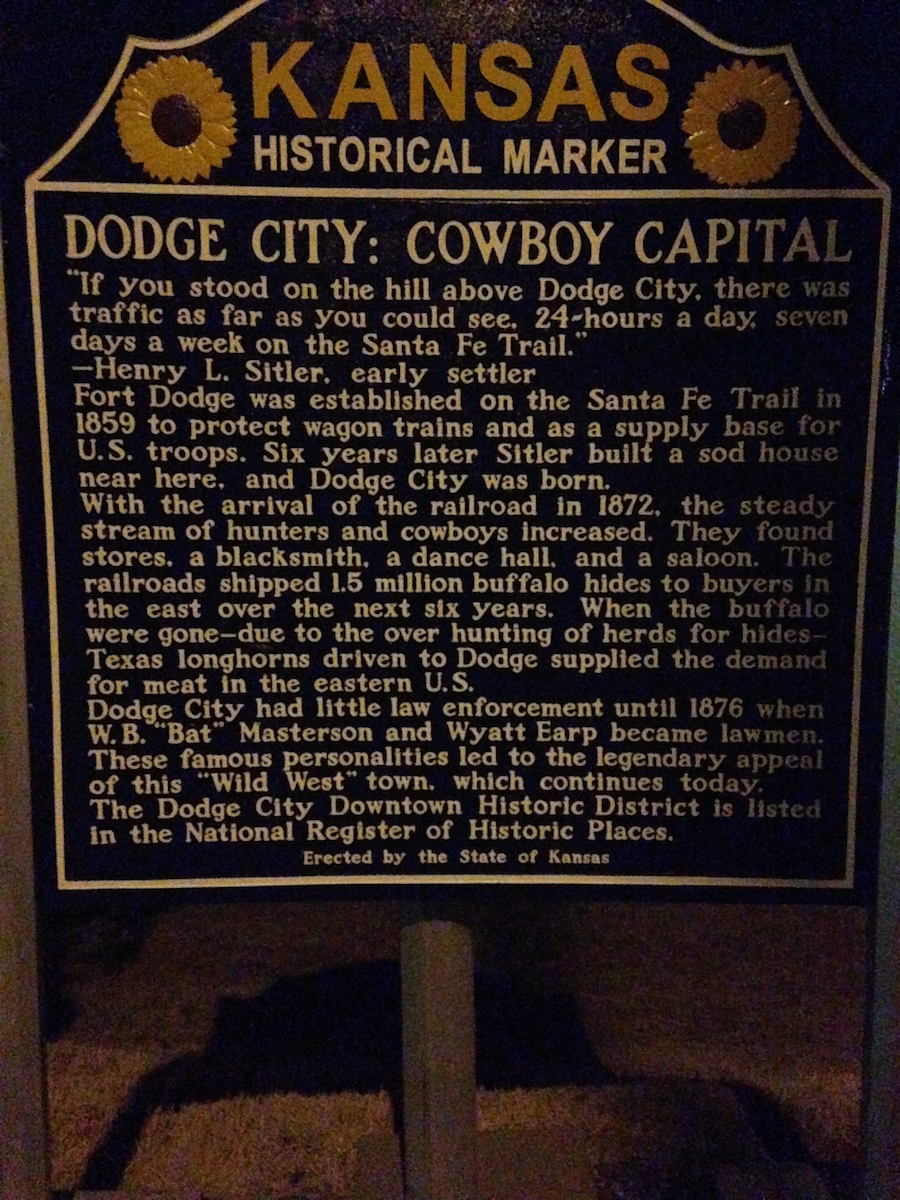
DODGE CITY: COWBOY CAPITAL "if you stood on the hill above Dodge City, there was traffic as far as you could see. 24-hours a day, seven days a week on the Santa Fe Trail. - Henry L. Sitler, early settler
Fort Dodge was established on the Santa Fe Trail in 1859 to protect wagon trains and as a supply base for U.S. troops. Six years later Sitler built a sod house near here, and Dodge City was born.
With the arrival of the railroad in 1872, the steady stream of hunters and cowboys increased. They found stores, a blacksmith, a dance hall, and a saloon. The railroads shipped 1.5 million buffalo hides to buyers in the east over the next six years. When the buffalo were gone - due to the over hunting of herds for hides - Texas longhorns driven to Dodge supplied the demand for meat in the eastern U.S.
Dodge City had little law enforcement until 1876 when W.B. "Bat" Masterson and Wyatt Earp became lawmen.
These famous personalities led to the legendary appeal of this "Wild West" town, which continues today.
The Dodge City Downtown Historic District is listed in the National Register of Historic Places.
Nearby in Kinsley Kansas:
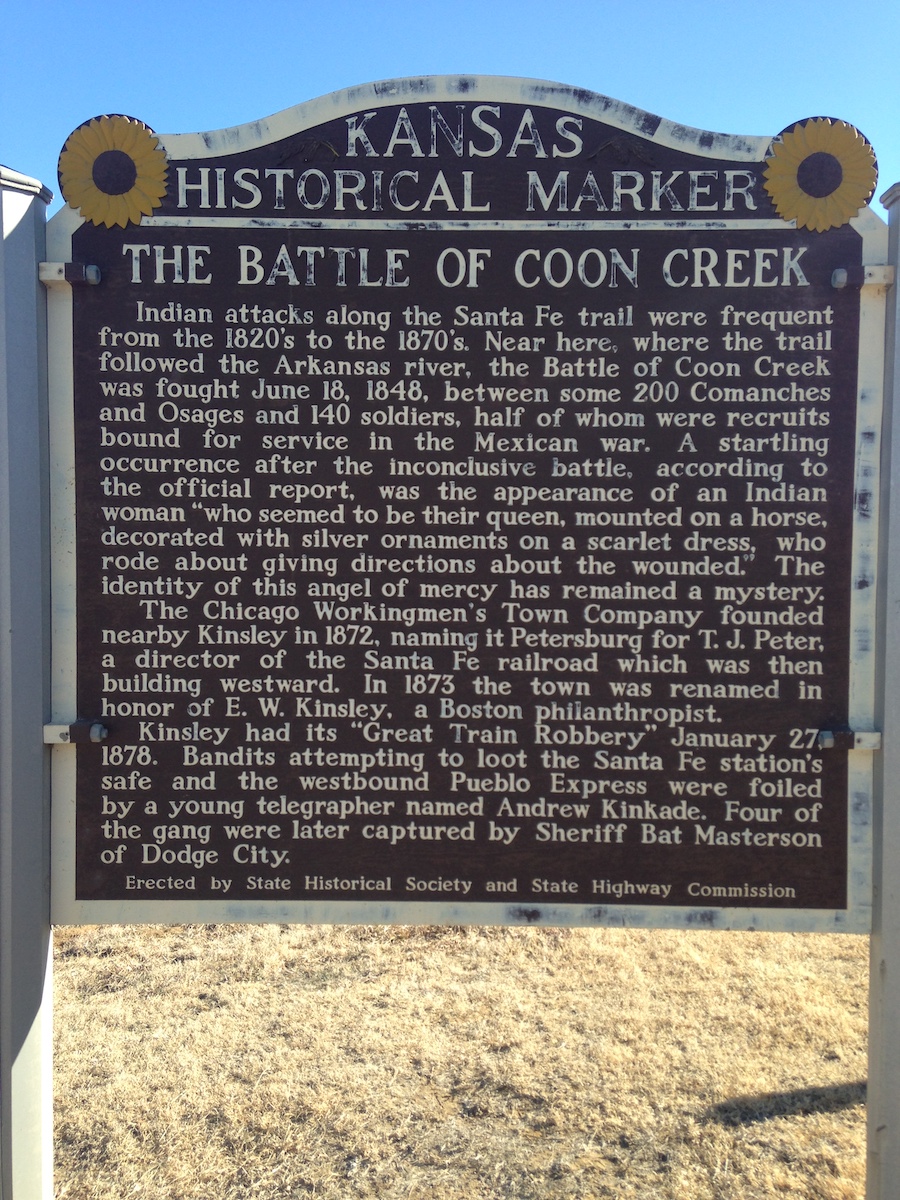
THE BATTLE OF COON CREEK
Indian attacks along the Santa Fe trail were frequent from the 1820's to the 1870's. Near here, where the trail followed the Arkansas river, the Battle of Coon Creek was fought June 18, 1848, between some 200 Comanches and Osages and 140 soldiers, half of whom were recruits bound for service in the Mexican war. A startling occurrence after the inconclusive battle, according to the official report, was the appearance of an Indian woman "who seemed to be their queen, mounted on a horse, decorated with silver ornaments on a scarlet dress, who rode about giving directions about the wounded." The identity of this angel of mercy has remained a mystery.
The Chicago Workingmen's Town Company founded nearby Kinsley in 1872, naming it Petersburg for T. J. Peter, a director of the Santa Fe railroad which was then building westward. In 1873 the town was renamed in honor of E. W. Kinsley, a Boston philanthropist.
Kinsey had its "Great Train Robbery' January 27, 1878. Bandits attempting to loot the Santa Fe station's safe and the westbound Pueblo Express were foiled by a young telegrapher named Andrew Kinkade. Four of the gang were later captured by Sheriff Bat Masterson of Dodge City.

